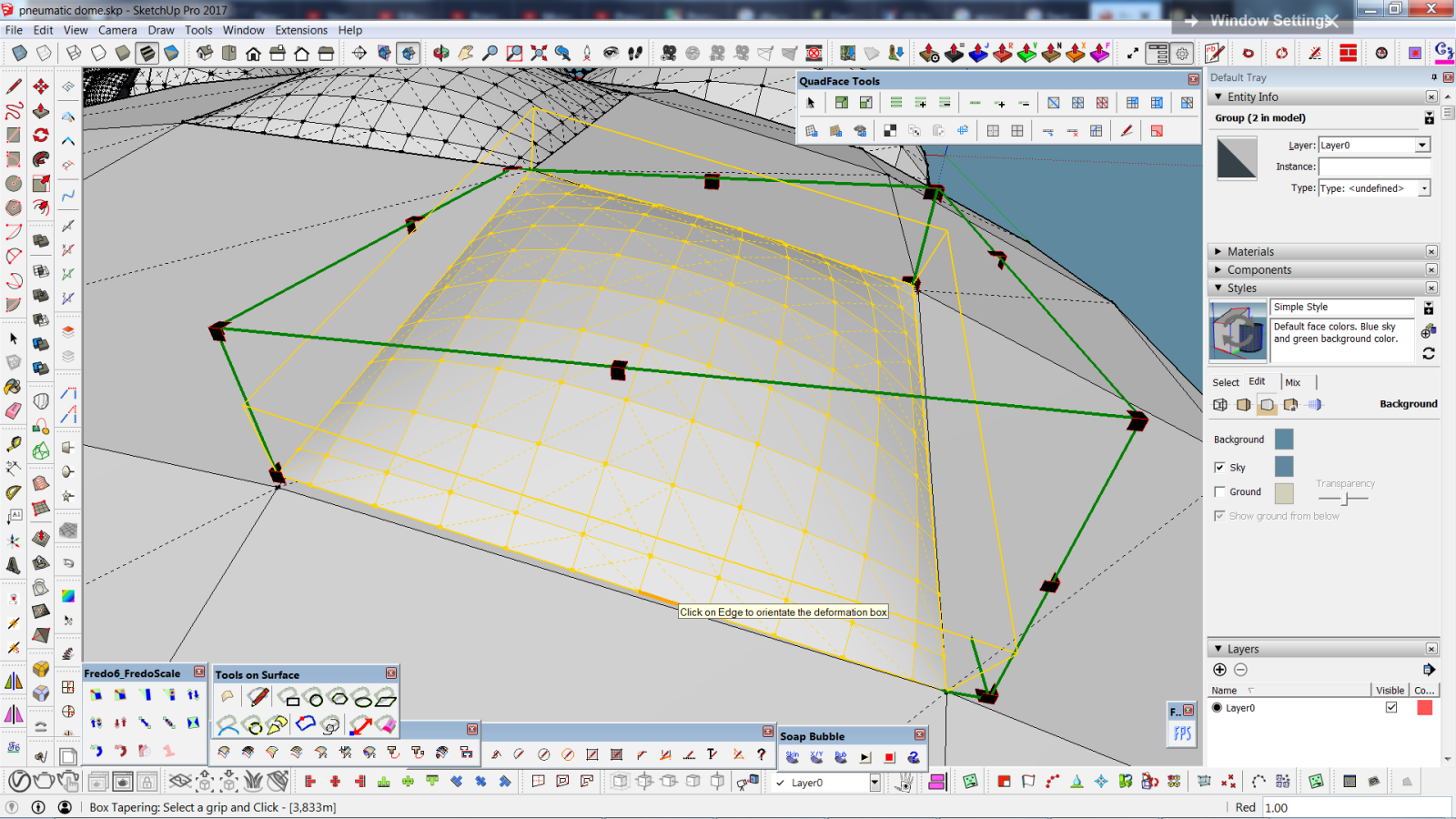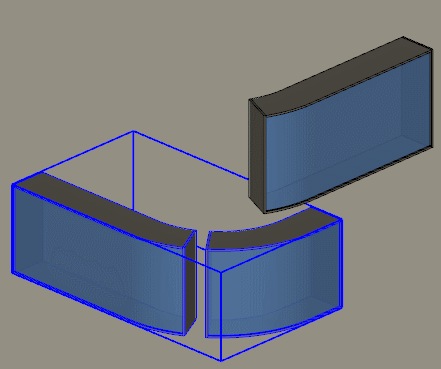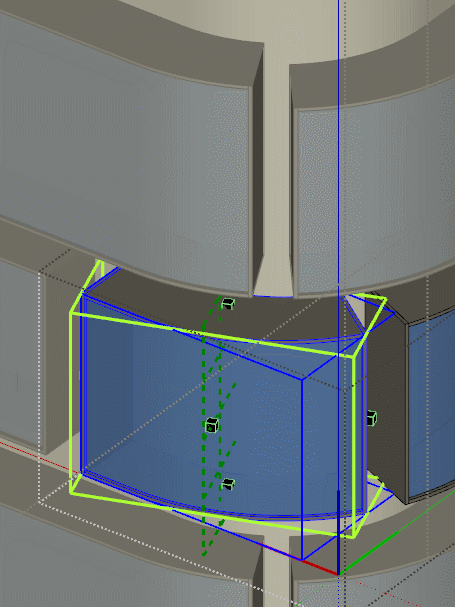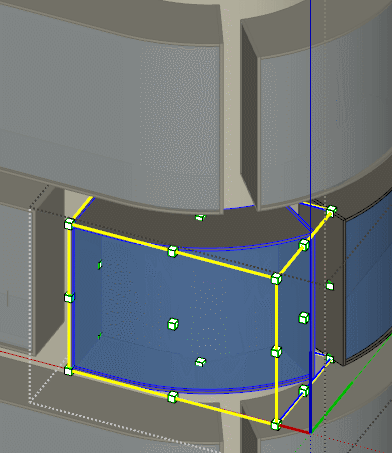[Plugin][$] FredoScale - v3.6a - 01 Apr 24
-
Hi!
I have problem matching deformation box to my group's bounding box. Normally it goes by clicking an edge of a target group but my group is rotated and mesh is more complicated (not just cuboid) so clicking one edge doesn't do proper matching. Is there an option like "match deformation box to gruop's bounding box"? so that deformation box would be matched just as with normal scale tool.
- 4 months later
-
Hi Fredo, muchos gracias for this awesome plugin!
Recently I stumbled upon a problem. Aiming at stretching models of woodworking furniture (say, a bookcase) to individual sizes (width, depth, height) the standard method of SketchUp (Scale) scales everything evenly, that is, the thickness of the material, the hardware, the proportions of moldings etc.) which renders it useless. Stretching with FredoScale does exactly, what I looked for. However, after applying that function kind of disintegrates the model, respectivly make multiple used components unique. That is, before using that function, changing one instance of the component A changes every instances of A - intended behavior. After using that function, changing one instance of the component A does not change the other instances. Whoops!
Ist there
(a) something I'm doing plain wrong?
(b) some limitation with your plugin?
(c) another way to stretch models along an imaginary section through the model?Thanks in advance!
-
@hafer said:
After using that function, changing one instance of the component A does not change the other instances. Whoops!
Ist there
(a) something I'm doing plain wrong?Yes. It sounds like you aren't opening the component for editing before running Box Stretching. If you were going to modify the components with other tools, you would need to open one instance for editing first. You need to do the same with Fredoscale as well.
@hafer said:
(b) some limitation with your plugin?
Not anymore limitation than any other tool has for modifying components.
@hafer said:
(c) another way to stretch models along an imaginary section through the model?
It can be done with native Move tool. Select the geometry that needs to move with the dimension change and use the Move tool to move that by the required distance.
- 2 months later
-
NEW RELEASE: FredoScale v3.1a - 18 Dec 18
Requirement: LibFredo6 8.7a
FredoScale 3.1a provides a Quick Launcher for all FredoScale tools. The divider is also enabled by default for the Stretch tool.
Home Page of FredoScale for information and Download.
- 2 months later
-
Fredo,
Maybe I as usual miss something but I thought it'd be a great improvement if there was an option to pull the grip and then input a number with +- with units abbreviation. Say +50cm.
And the tool would incrementally add 50cm in ordered direction. It'd be super awesome if it could add (those 50cm) to multiple objects simultaneously.
P.S. I attach something with some overhelming features, maybe it could be interesting for you -
@rv1974 said:
Fredo,
Maybe I as usual miss something but I thought it'd be a great improvement if there was an option to pull the grip and then input a number with +- with units abbreviation. Say +50cm.
And the tool would incrementally add 50cm in ordered direction.It's difficult to do it in the VCB because FredOscale would not know if you talk about the scale factor or the dimension, and in absolute or relative term.
What you can do currently is
- hover a handle
- Press TAB
- you get a dialog box where you the dimension(s), one, two or three fields depending on the active handle.
Since formulas are supported in the dimension fields you can modify the field and type "+50" or "+50cm".
Fredo
-
-
Yes. This is a bug which is on my list. This happens when you try to get the inference from an object which is another instance from the component you scale. My code for avoiding self-referencing need to be adjusted.
-
@rv1974 & @fredo6
I noticed that when you use "box stretching to target" (that is, when you double click the control boxes), Inferencing usually works fine... even with objects outside the group (nevertheless it would be nice if it would work without using "box stretching to target").@fredo6
When I scale any components (with box stretching), Fredoscale makes it a unique component. This is reasonable when I just scale one component, but if I scale two or more of the same component and at the same time, it would be nice if they still stay as the same, and don't become unique.Thanks for your hard work.
Greetings,
Mileno. -
@Mileno no help from double clicking on my end
-
@rv1974 said:
@Mileno no help from double clicking on my end
Penny has dropped:
click black grip->then click 1st referece point->finally click 'where-to' point.
This way it works perfectly.
Thank you Fredo - about a month later
-
Hi!
I'm trying to bend a piano keyboard into a closed circle.
Is it possible to do using the Radial Bend tool?
I'm not figuring out what the target point is.
Thanks!
-
@nesh70 said:
Hi!
I'm trying to bend a piano keyboard into a closed circle.
Is it possible to do using the Radial Bend tool?
I'm not figuring out what the target point is.
Thanks!
Not possible. Maximum is 180 degree, that is a U-turn
-
44 keys at time?
- 27 days later
-
This plugin is fantastic, it made my life so much easier. Thank you!

Is this a place where you can put a request?
- Could you make snapping more like a native Sketchup scale tool? I mean, FredoScale/Stretch doesn't snap to lines outside the component and I think it doesn't snap to surfaces at all.
- Would it be possible to Scale/Stretch by a specified additional lenght? For example if you want to stretch something so it's 20cm longer. Then instead of putting a scale factor you put +20 (or respectively -20 if you want to shorten it by 20cm).
-
@kubap said:
- Could you make snapping more like a native Sketchup scale tool? I mean, FredoScale/Stretch doesn't snap to lines outside the component and I think it doesn't snap to surfaces at all.
I'll look at it. This can probably be done, but I need to remember why I excluded them
- Would it be possible to Scale/Stretch by a specified additional lenght? For example if you want to stretch something so it's 20cm longer. Then instead of putting a scale factor you put +20 (or respectively -20 if you want to shorten it by 20cm).[/quote]
The best is that you just hover the handle you wish to move, then type TAB. In the dialog box, you can type formulas, so add a "+20cm" at the end of the current value.
- about a month later
-
- 3 months later
-
The signature is out of date
-
@theresacalabrese said:
The signature is out of date
To what signature are you referring? SketchUp says the signature is up to date:
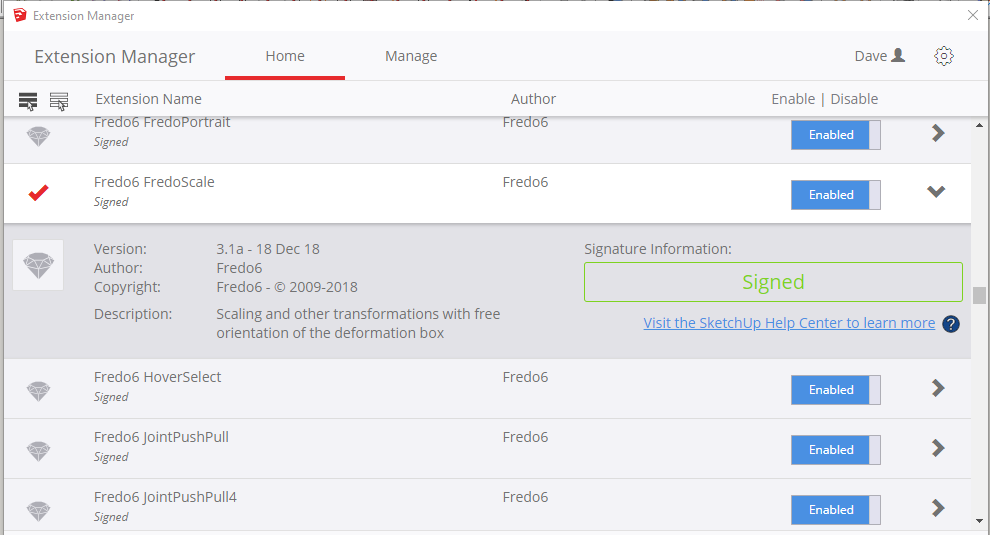
- 16 days later
-
@kevsterman said:
Hi guys. I have another question regarding radial bend. As you can see from the image all of the lines denoting brickwork haven't bended as I was expecting. I'm not sure why. Is it a parameter problem or maybe something to do with the model? Its probably something really easy I'm missing

[attachment=0:1s1lyd44]<!-- ia0 -->Screenshot 2017-08-10 13.03.15.png<!-- ia0 -->[/attachment:1s1lyd44]
You need to split the horizontal lines into segments. The same would happen if you used a circle with only eight segments, it would transform into a funky shape, because the lines connect to the points, and only the points are relocated. (Eg, it will not curve a solid line, it just deforms the locations of the end-points.)
Thus, your windows where they are on the roof-line, that has three segments. The points are relocated, on a curve, and you get a three-segment curve. However, your horizontal lines for the "siding", only have two points, per line. So, the line just connects from point to point, left and right, with no curve on the line, to match the line where the window has broken the line into three segments. Just as you would add more segments to a circle to hide the fact that it is actually just a bunch of lines and angles, to create the illusion of a "curve".
Resolutions...
1: Break the line into a three-segment line, by adding a line with points aligned under the window, where the window points intersect that horizontal line of the roof.
2: For more realism, because that is a rather large curve, you should segment each line into 4-8 segments per line. That way, you will have full curves, retaining the "image/concept", of the original.
This is the reason that SketchUp has no deform tools. When done on simple lines, without adding more segments, you get undesired results. Just as when you attempt three-point perspective, by lowering the camera near the ground and looking up. It always "looks funny", because the building edges are all perfect lines from corner to corner, instead of having a "true curve", as a camera or your eyes see. That is why 3D rendered things, look like 3D rendered things, instead of looking like reality, unless you use post-work deforms or complex multi-segment lines. (As objects such as people have, but buildings normally do not. Adding to the oddity of displaying 3D objects.)
Advertisement

